Turning the tide Turning the tide Turning the tide
Seattle’s waterfront is getting a major makeover — with a little help from the UW.
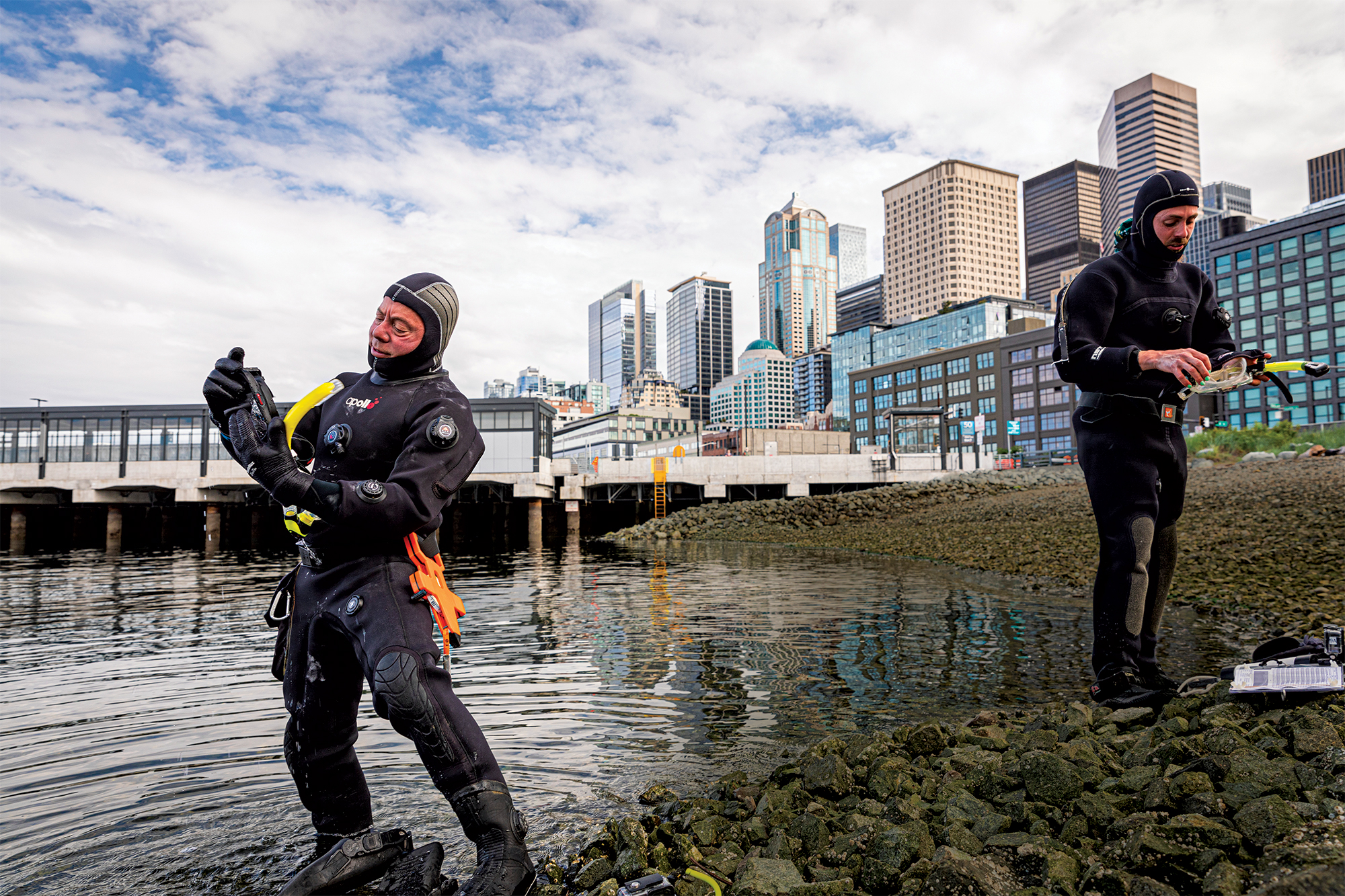
Seattle’s waterfront is getting a major makeover — with a little help from the UW.
Catalina Burch and Mike Caputo, ’10, snorkel along the new Seattle seawall, clad in dry suits and carrying wet-dry clipboards and flashlights on a cloudy August morning. As is often the case, it doesn’t take long before passersby on the sidewalk above take notice of the UW’s Wetland Ecosystem Team members and start shouting questions.
“It’s interesting,” Burch, a graduate student, says later as she’s gearing up for another swim. “Most people think we’re doing water sampling. It’s always fun and interesting that that’s the first thing they think. Like, they don’t really imagine there are fish out here.”
Not only are there fish—there are more and more of them each year. Along the seawall, which was designed with the help of UW scientists and engineers and serves as the foundation for the city’s new waterfront, the researchers count herring, shiner perch, sand lance, a growing host of invertebrates and, most importantly, salmon. All kinds of salmon.
This is just one place where the UW’s expertise touches on Seattle’s new central waterfront project, an $835 million public-private effort to reconnect the city’s downtown with Puget Sound. Designed to undo more than a century of mistakes, missteps and neglect, the finished project will be a showpiece that stretches north from Pioneer Park to beyond Pike Place Market. With parks and art, shops, walking trails and performance spaces, it will rival any urban waterfront in the world. But you won’t be able to see all the magic from dry land.
“What we’re doing now is we’ve got a whole new front door. It’s just an amazing legacy that the city, the current generation, is leaving for the future.”
Nori Sato, ’74, an artist working on the project
“Stick your head in the water and it’s a different place,” says UW research scientist Bob Oxborrow, ’12.
“I was surprised on my first snorkel that there’s so much life down under the pier,” adds Burch. “All the sea stars and sea cucumbers, lots of schools, thousands of herring. It’s unexpected.”
The restoration of habitat is among the first of many positive effects of the project. The multibillion-dollar retooling of Seattle’s transportation and infrastructure plan includes a massive new $113 million Ocean Pavilion for the Seattle Aquarium, playgrounds, a new walkway from Pike Place Market to the waterfront, rerouted traffic patterns, pedestrian and bike paths, a new ferry terminal, piers large enough to hold concerts, a stormwater filtering system and—startlingly—a rocky stretch of beach.
* * *
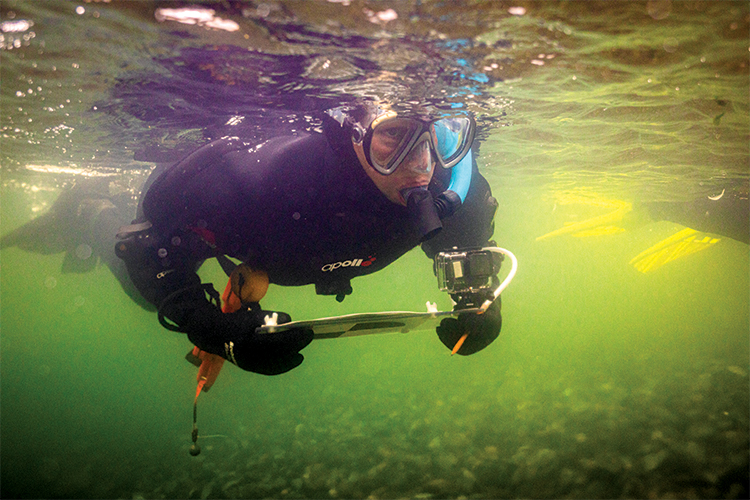
Scientists Mike Caputo, ’10, and Bob Oxborrow, ’12, snorkel with clipboards to make notes on the fish they encounter.. At top, the two members of the UW Wetland Ecosystem Team enter the water off the edge of downtown to study the health of nearshore wildlife.
The project kicked into high gear with the removal of the Alaskan Way Viaduct in 2018-19, and its best elements are already emerging. The city made use of the UW’s Climate Impacts Group sea level rise projections in planning. Before that, seismic studies, historical assessments and statistical traffic reviews were among the dozens of different ways UW research and expertise had been put into use for the project.
And by the time it’s complete in 2025, hundreds of UW graduates—with degrees in engineering, urban planning, fisheries, architecture and business—will have participated. “The UW’s tentacles are all over it,” cracks Tim Kuniholm, ’90, the Seattle Aquarium’s director of public affairs and marketing. He points to project managers, contractors, elected officials and city staff.
“I think the power of this story is how many University of Washington alumni are involved,” says Ben Franz-Knight, ’96, former executive director of the Pike Place Market and a project consultant on the the Aquarium’s Ocean Pavilion project. “It’s just massive. I mean, the mayor [Bruce Harrell] who’s going to cut the ribbon on this thing, he played football at UW.” Franz-Knight himself was president of the UW Alumni Association of Board of Trustees.
The list includes Angela Brady, ’95, a civil engineering graduate who directs the Seattle Department of Transportation’s Waterfront Program. At last count, she says, there were 16 UW alumni in her department alone. And there are nine UW grads at Friends of Waterfront Seattle, the nonprofit that will oversee the area after it’s complete.
“There are multiple [Husky alums] that I work with who, whether they’re engineers or contractors or project managers or architects, this is an investment of a decade or more of their lives,” Franz-Knight says.
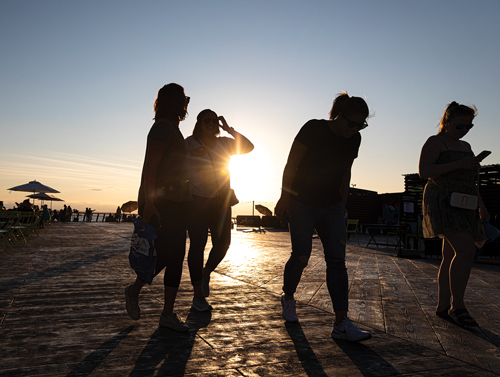
The waterfront already features the Seattle Great Wheel at Pier 57, which opened in 2012, and picture-perfect sunsets.
The Aquarium’s Kuniholm believes the connection makes sense: “The UDub community is so connected to the water. If you’ve ever sailgated into a Husky home game, or you’re on a canoe in the Arboretum or visiting the Shell House, you’ll understand the University’s long, rich history and connection to the water.”
That connection is what landscape architecture professor Nancy Rottle and her colleagues wanted their students to consider when they envisioned the future of Seattle’s waterfront as an active, vibrant public space to serve a multicultural, intergenerational population. It deserves the attention, Rottle says: “It’s Seattle’s birthplace. It’s where the city meets the water.”
In 2011, Rottle’s students produced a study that emphasized bringing pedestrians and bicyclists down to the water’s edge and making landscape decisions that would help undo ecological damage that continues even now as untreated stormwater flows into Elliott Bay.
“There’s that idea that we shape our environments and our environments shape us,” Rottle says. “As designers, we believe that. So I think those elements are really critical.” The project they imagined can’t undo decades of abuse, Rottle says. But it “recognizes it’s a waterfront and that here’s a whole ecology to that waterfront that is really critical to these juvenile salmon that are swimming along it.”
Rottle and her team of scholars and students offered a vision of how to knit it all together: the landscape, the ecology, the ferry terminal, the public spaces, the aquarium and the businesses, says Maggie Walker, ’74, of the Friends of Waterfront Seattle board. The nonprofit is a partner to the city of Seattle to help fund and build a new waterfront and to create exercise, education and entertainment programs for the park. The idea of tying everything together into one big project informed the hiring of James Corner Field Operations, the landscape architecture firm that led the design and construction of the High Line in Manhattan.
According to Aquarium CEO Bob Davidson, ’00, the project probably got its start with Seattle Mayor Paul Schell. Davidson remembers a meeting where Schell, a former dean of the UW College of Built Environments, who was then head of Seattle’s Office of Economic Development, offered a new vision for the city.
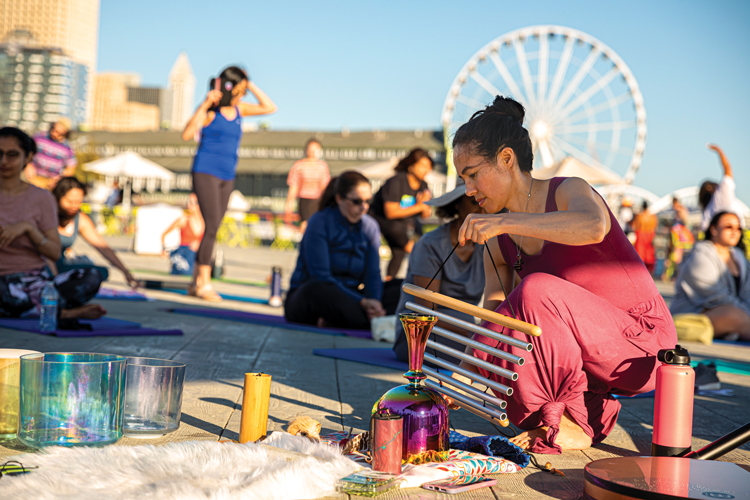
Mary Ann Stancel, ’04 leads a sound journey meditation for visitors to Pier 62.
“He had a model of the downtown, including the waterfront and the viaduct,” Davidson says. “So he started by walking around the model and removing the viaduct, dropping it on the floor and saying, ‘This is where we should be going in this city.’ And everybody thought, ‘Oh, nobody’s going to move the viaduct.’”
Just a few years later in 1995, a UW engineering team reported on the seismic vulnerability of the viaduct to the Washington State Department of Transportation, triggering planning for repair or replacement. Then in 2001, the Nisqually earthquake, the 6.8 temblor that was the biggest to strike the state in a generation gave city leaders the opening they needed to swing for some of Schell’s conceptual fences. Not only did the quake expose the viaduct as vulnerable, it also destroyed a portion of the already cracking and crumbling seawall.
“That’s the opportunity you needed to pull this off,” Franz-Knight says. “If you have to replace a seawall along a major urban waterfront, that’s your opportunity right there.”
One of the first pieces—and one of the largest ecological engineering projects in history—was the $410 million seawall restoration project. The old haphazard structure was replaced with a new seismically sound wall designed to improve the marine habitat, especially for juvenile salmon.
Jeff Cordell, a UW aquatic and fisheries scientist, helped design the textured-and-stepped wall to offer small fish and other important creatures protection from predators. Glass blocks dot the waterfront walkway above, allowing daylight to filter down so juvenile salmon can find the small creatures they eat. Jason Toft, ’00, who studied with Cordell, now monitors the aquatic life there as head of the Wetland Team. He and his crew are already seeing improvement after a decade of monitoring, though not all nearshore species have returned.
“When I talk to people when we go to meetings worldwide, they’re noticing that Seattle has pulled this off on a larger scale than has happened elsewhere,” Toft says. Now other cities are asking for his expertise. “People are paying attention.”
People have been paying attention to this little stretch of land for millennia. It was already a long-established population center for Indigenous people when white settlers founded Seattle in 1851, and it’s had many iterations in the decades since, evolving into a place of alternately starry-eyed and morbid fascination. Everybody who has been there has a waterfront memory, whether it was visiting the Aquarium or the Seattle Great Wheel at Pier 57, or getting into trouble on a Friday night as a teen or wandering through the wonderfully weird shops and seafood joints along the piers while leading out-of-towners on a tour.

A sample of tiny aquatic creatures is examined back on campus.
Davidson’s early memories are family drives from Tukwila in the 1950s. Each trip was its own adventure. “We’d go to the Ivar’s Fish Bar, and that was a treat,” he says. “We’d park under the viaduct and somebody would go in and pick up fish and chips and we’d eat in the car. And that was our waterfront exposure. The waterfront was very gritty.”
Gritty might be a kind description. Scary. Dangerous. Exhilarating. Mysterious. Historian Jennifer Ott, ’93, says all apply. The assistant director at HistoryLink, an online encyclopedia of Washington state’s history, leads biweekly walking tours, exposing the fascinating and complex history along a mile-long stretch.
“The waterfront is the core of Seattle’s business community in those early years, and it was absolutely makeshift,” Ott says. “It drives civic leaders nuts that this is our core economic driver, and we are basically having parts of it fall into the water.”
Seattle’s early planners had three major obstacles, Ott says. The first two were a general lack of level land and Denny Hill, the bluff that abutted Elliott Bay. North of modern-day Madison Street, it wasn’t possible to build a traditional seawall because of a steep drop-off along the coastline. But the Depression brought government funding and labor, and the city began to regrade Denny, moving the hill and driving wooden pylons and pouring concrete footings to create the waterfront we’ve been familiar with for the past near-century.
“And then the third sort of major issue that has plagued the waterfront forever, and still does, is it’s a really important north-south corridor,” Ott says. “But it’s an equally important east-west corridor. So how do you accommodate both? … Now it’s more of a psychological barrier. How do you fuse these areas together: the uphill part of town and the waterfront?”
* * *
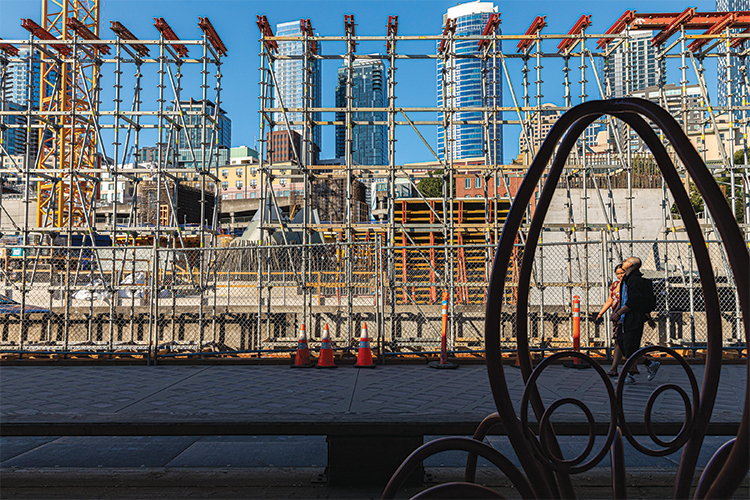
Just across from the Seattle Aquarium, a new Ocean Pavilion rises on land that used to be under the Alaskan Way Viaduct. When it’s completed in 2025, the aquarium addition will also be part of a structure with rooftop parks, stairs and walkways that connects Pike Place Market to the waterfront below.
Despite the obstacles, life went on in the viaduct’s shadow, and more memories sprouted. For 30 years, artist Norie Sato’s studio was in an old building that sat near the south end of the viaduct like a mushroom under a tree. She moved in after completing her MFA at the UW, joining a collective of artist alums who formed Triangle Studios. She didn’t realize it at the time, but the spot held even more personal history, something she reflected on in a 1991 pop-up show along the waterfront.
“It really was about my coming to the U.S.,” says Sato, ’74, who emigrated through Seattle with her parents when she was 5, then returned to the city years later to attend the UW. “The ship that came from Japan landed at Pier 50. Pier 50 was really outside my studio window. I was in the studio there for so many years without really realizing that I was looking out on this area because Pier 50 had been torn down. That was kind of a really interesting circle that occurred, you might say.”
Sato has been commissioned by the city to install one of seven new large-scale art pieces for the waterfront project. Hers is a tall fern frond that wraps around a showcase stairway at Union Street and Alaskan Way. It’s meant to mimic the ferns that grew irrepressibly out of the wall on that very spot, resistant to all efforts to eradicate them over the decades. Sato believes the resilient fern is an apt metaphor for the waterfront.
“It is just an amazing change for Seattle,” Sato says. “What we’re doing now is we’ve got a whole new front door. It’s just an amazing legacy that the city, the current generation, is leaving for the future.”
Already, it is something to behold. When Franz-Knight stands in front of the Aquarium—a place almost all Seattle residents and visitors have stood at least once—he can already see it in his head. The finished project will dramatically swoop down from Pike Place Market over a rerouted Alaskan Way to the Aquarium’s new Overlook Pavilion. From there, sweeping stairs will take you down to Elliott Bay.
Franz-Knight worked on the project from 2010 to 2017 when, as its executive director, he led the market’s Puget Sound-facing upgrades in preparation for the viaduct’s demolition.
He can’t wait for that day in 2025 when the project is complete and he can make that unbroken climb from the Aquarium to the market. It’ll be a little like walking on clouds. “That will be a very notable day,” he says. “I get a little emotional thinking about it.”
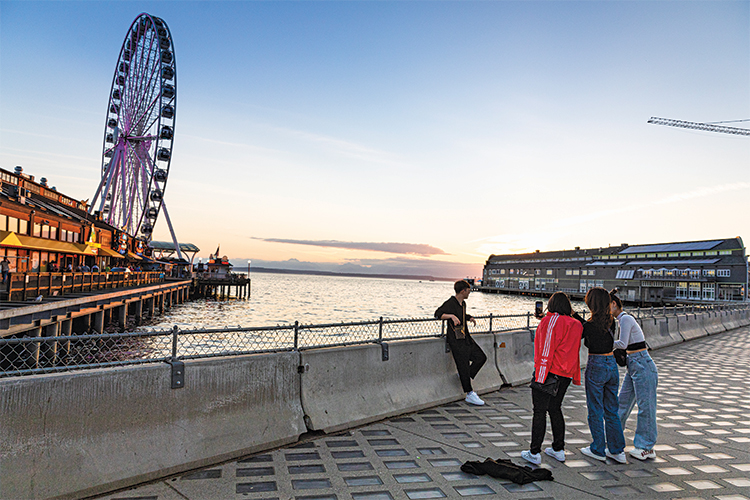
Visitors stand atop a sidewalk filled with glass blocks to allow sunlight to filter to the water below, where salmon fry and other small creatures seek shelter against a new seawall.